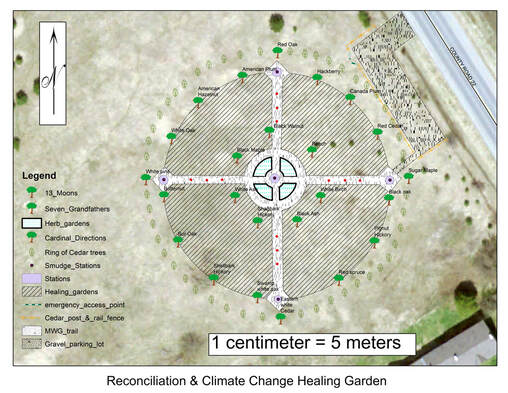|
In partnership with community groups and organizations, including Forests Ontario and South Nation Conservation, Plenty Canada planted 250 culturally significant trees on the traditional territory of Algonquin and Mohawk peoples in Shanly, Ontario. Dubbed “The Healing Place,” it represents the beginning of reconciliation efforts seeking to strengthen relations between Indigenous and non-Indigenous communities in support of sustainable and shared environmental initiatives. The design of the Healing Place was created with the intent of representing practices acknowledged by both Indigenous knowledge systems and western science. Planted as a circular area modelled after the Anishinaabek Medicine Wheel, its quadrants represent the four pillars that connect life: Mental, spiritual, emotional, and physical. Furthermore, the quadrants also represent the four cardinal directions which both centre and guide all peoples. The specific colors of the Medicine Wheel vary between cultures, but for this project the four stations of the site were colored red, white, yellow, and black. The species of trees chosen for the project were also meant to be broadly appealing in a symbolic sense. The four cardinal directions are highlighted through planting an appropriate tree at the edge of each quadrant (for instance, a red oak is planted due north). The interior of the Healing Place's centre garden contains seven trees, representing the Seven Grandfather Teachings. The outside area of the garden is surrounded by an additional thirteen trees, representing the Thirteen Grandmother teachings. The entire garden will eventually contain walking trails, so that The Healing Place can become a publicly available space for relaxation, education, and reconciliation. The project began at a 2019 meeting of the Assembly of First Nations in Whitehorse, Yukon. Two members of the Assembly, Curtis Scurr and Eli Enns, discussed the possibility of offsetting the carbon they expended in order to travel to the conference. It was decided that tree planting would be an effective (and tangible) way to offset the carbon expended by the event. They brought this idea to Plenty Canada's Executive Director Larry McDermott, who then invited additional partners into the fold. Forests Ontario, which is dedicated to making Ontario’s forests greener, joined quickly and secured a location for The Healing Place through a partnership with South Nation Conservation, an agency that has a long and strong history in watershed management and sustainable practices.
Though the planting event itself was a tremendous accomplishment, Plenty Canada and its project partners hope to continue to expand their environmental conservation and reconciliation efforts throughout the coming years. The group envisions planting multiple “healing places” to provide tangible offsets that help community and business organizations hold themselves accountable for their own carbon emissions. (Top Photos: 1) Bill Montgomery, Haida, Indigenous Education Lead with the Upper Canada District School Board and Chris Craig, Algonquin, Senior Forestry Technician at South Nation Conservation preside at ceremonies for The Healing Place. 2) Aerial view of the opening ceremony at the Healing Place)
0 Comments
Your comment will be posted after it is approved.
Leave a Reply. |
|
-
Home
- Donate
-
Projects
-
Canada
>
- Plenty Canada CampUs
- The Healing Places
- Two-Eyed Seeing Bird Knowledge
- Niagara Escarpment Biosphere Network
- Greenbelt Indigenous Botanical Survey
- Great Niagara Escarpment Indigenous Cultural Map
- Ginawaydaganuc Indigenous Food Sovereignty
- Indigenous Languages and Cultures Programs >
- Wild Rice
- Good Mind Grappling (partnership)
- Ginawaydaganuc Village (partnership)
- Youth Programming >
- Americas >
- Africa >
-
Canada
>
- News
- Resources
- Partners
- Contact Us
Our Location266 Plenty Lane Lanark, Ontario Canada K0G 1K0 (613) 278-2215 |
Donate to
|
Subscribe to our Newsletter |

